“In team play, golfers call this ‘ham and egging it.’ Translated, it means when one player is in trouble, the other is saving the day.”—Charles Clines, Fort Worth Star-Telegram, 1986
I heard the story secondhand two weeks ago at our annual friends Ryder Cup event, and it made me mad. Two of my friends, Aaron and Drew, played a terrific scramble match on the final day and beat a team that was superior on paper. When Aaron was out of a hole, Drew was on fire, and vice versa, all the way to a dominant 5-and-4 win. It was a classic case of ham-and-egging—the phrase used to describe when two match-play partners pick up each other’s slack, playing well by turns rather than playing well or poorly at the same time.
Say it out loud: “ham and egg.” It’s very fun, landing right in that sweet spot where descriptive and goofy collide. And because Aaron and Drew are smart people, it’s no surprise that they started analyzing the expression after their match.
Which brings us to the part that made me mad: Drew argued that in this context, the ham represented good golf, while the egg represented bad golf. I repeat: He thinks the egg is rotten. Now, we can all agree that when two players ham-and-egging, it’s usually the case that they are playing well at different times. However, Aaron and I strongly believed that Drew’s take on the two ingredients was nonsense. The “ham” and the “egg” are both good; they’re different but complementary foods, and they’re used in this expression to illustrate that the two players go well together. How dare Drew cast aspersions on the noble egg!
Typing it out now, I realize this is among the dumbest debates I’ve ever been involved in, and that’s before the discussion branched out into whether ham is actually a good breakfast food (I contend that salty country ham is incredible and anyone who disagrees is a fatally flawed human being). Still, the more I thought about it, the more I realized I couldn’t prove anything, and the more I wondered where the odd phrase came from. Why ham and egg? Does it apply to any other sport? Could Drew have been right that the egg is supposed to be bad?
Spoiler: No. Drew was dead wrong, and I won’t let him forget it. But beyond that grudge, I made it my mission to dig into the etymology of golf’s ham-and-egg fixation. Here’s what I found.
Did anybody else think this? I had a memory, which may be false, of Justin Rose or Lee Westwood or some different English person entirely doing a little staged bit where they said “Mr. Ham!” with an elaborate bow, while their partner answered “Mr. Egg!” In my mind, this went down at some Ryder Cup—maybe Medinah or Gleneagles?—and hinted at a pop culture, perhaps cartoony origin.
As I said, this may be entirely in my head. I promise the rest of this piece is better researched. But while there was a two-character Vaudeville-style act called “Hamm and Eggz” at Epcot’s “Future World” in the 1980s, they didn’t even call each other “Mr. Ham” and “Mr. Egg,” and anyway, the phrase predates the characters. Beyond that, I can’t find any indication that there was any ham-and-egg-themed cartoon, or that Rose or Westwood or anyone else ever said anything like I imagined them saying. It was at this point that I began to wonder if I was going crazy.
2. It seems to have started, in a sporting context, in boxing…and it meant something totally different.
Digging into the newspapers.com archive and sorting past literally thousands of “ham and egg” recipes in early newspapers, the first sports reference I could find came in a January 1912 article in the Morning Tribune out of Los Angeles. It was about a lightweight champion named Ad Wolgast, and it alluded to his early days, before he rose to the top of the world:
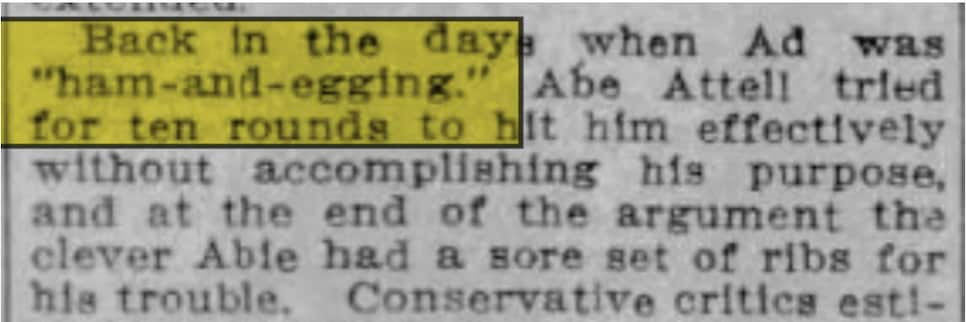
As you can probably tell from the context, to “ham and egg” it in boxing is akin to slumming it in the minor leagues—fighting in low-stakes bouts for just enough money to buy yourself dinner. To call someone a ham-and-egger was mostly derogatory, and while it could refer to a younger fighter gaining experience, as with Wolgast, it mostly refers to a down-and-out has-been with no talent and even less luck. In other words, a bum.
Here’s another example, from 1925 in The Day out of New London, Conn:

And one more, from the Washington Daily News in 1950, because it puts things so succinctly:
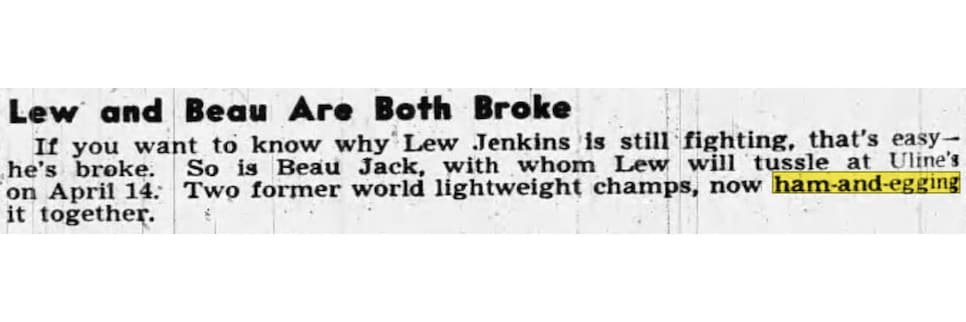 3. It’s also used in pro wresting.
3. It’s also used in pro wresting.
As far as I can tell, a “ham-and-egger” is a synonym for a “jobber”—someone whose job it is to lose to the real stars. Although it’s not quite the same definition as boxing, it carries the same connotation of a low-level grunt.
4. It’s also used in baseball.
I grew up playing baseball and had never heard this, but apparently a “ham and egger” is also slang for a tailor made double play. I’ve heard plenty of other baseball food slang, from “pickle” to “tater” to “pepper” to “can of corn,” but this one was new to me.
5. There are various other uses not related to sports.
“Ham-and-egger” can be an insult for an ordinary or hated person, “ham-and-egging” can just mean living on the cheap, and in Cockney rhyming slang, “ham and eggs” means “legs,” and “ham and egger,” means beggar. In the late 1930s in California, there was a “ham and eggs” proposal that would have offered $30 per week as a pension to residents 50 and older. It failed. Elsewhere, I even found a picture of some men by a pool in 1934, one of whom looks to be riding an inflatable sea horse, with the caption “here they are ham-and-egging, and how they love it!” I think this refers to the fact that it’s an initiation into a breakfast club, but I hesitate to speak with any authority on the matter.
 6. The first printed golf reference I could find came in 1960
6. The first printed golf reference I could find came in 1960
The first time “ham-and-egging” in its current golf form appeared in newspaper form, at least that I could find—and I searched every possible word combination you can think of—it was in The Daily Report from Ontario, Calif., just east of Los Angeles:

Next, in 1964, we see it 90 miles east in Palm Desert, Calif.:
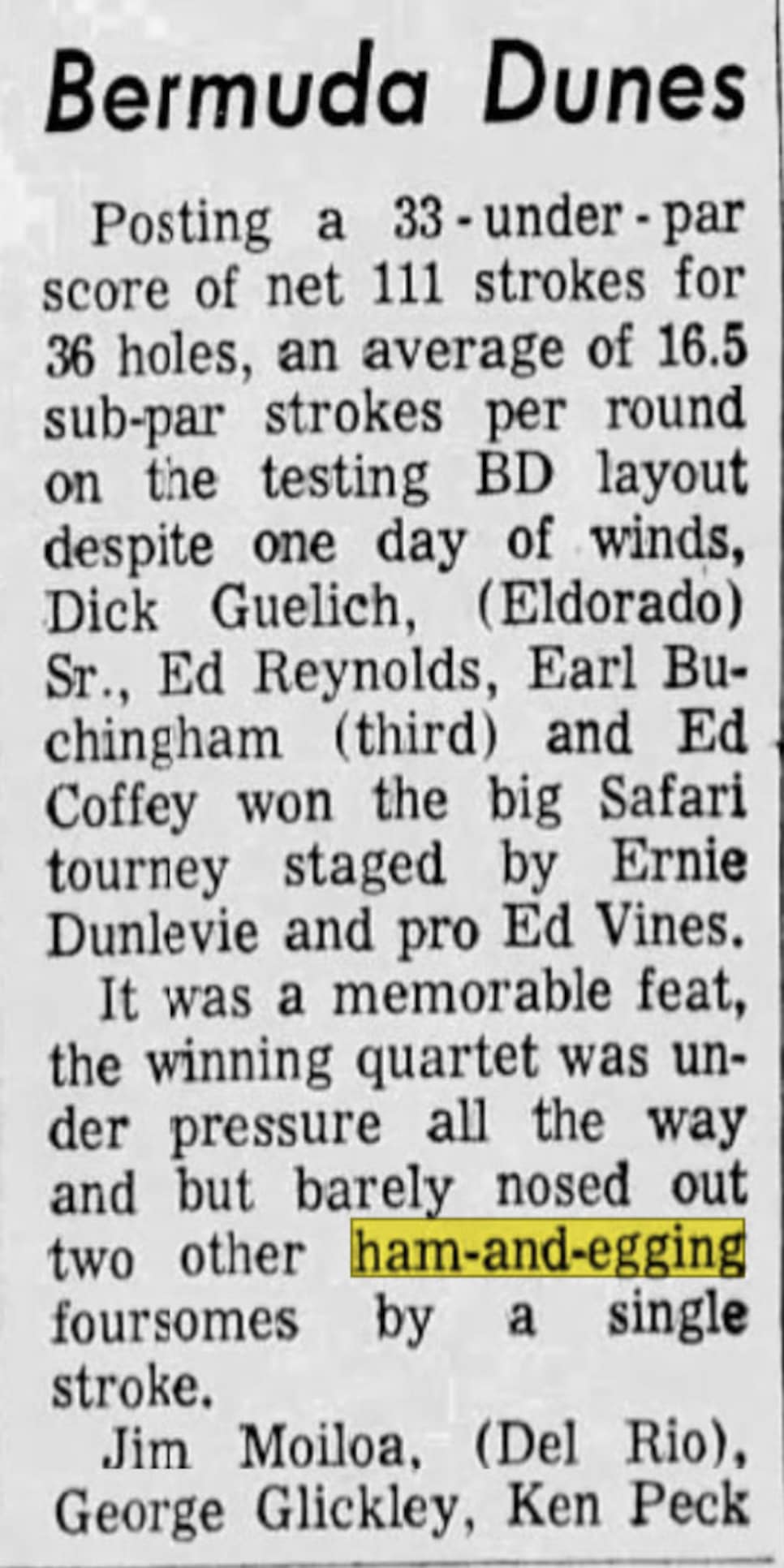
Now, are these two examples enough to prove that like a lot of new American lingo, “ham and egg” started in California? Unfortunately, no. I think it’s a reasonable assumption, but try as I might, I couldn’t find any direct evidence to where the phrase began, whether it evolved from boxing or just grew up wholesale, or when it happened. Which actually isn’t much of a surprise, because language, and especially slang, almost always evolves and takes root before it ever appears in print.
7. However, I did find an early explanation-slash-definition
I bring you now to 1966 and The Cincinnati Post. When columnist Pat Harmon (who worked at the Post for 34 years before he retired) wrote about the PGA National Team Championship, he spoke about the partnership between Jack Nicklaus and Arnold Palmer (who would go on to win the event). In the process Harmon gave a straight-up definition of “ham-and-egging,” as well as introducing a piece of vernacular I hadn’t seen before:
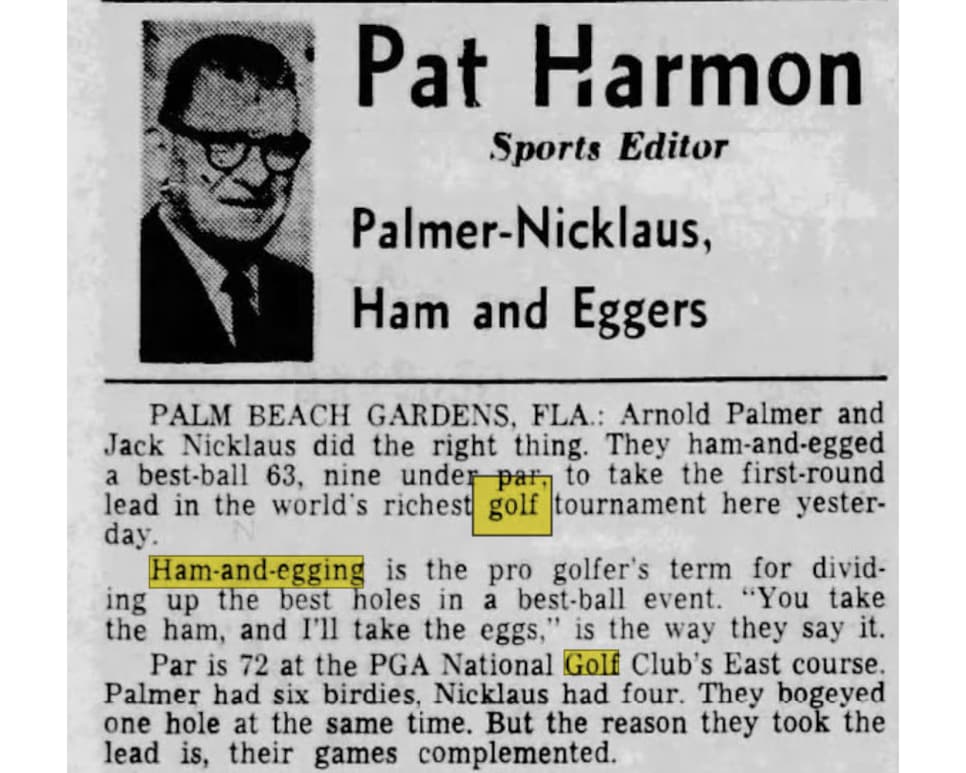
“You take the ham, and I’ll take the eggs.”
Huh. On one hand, this gives direct support to the idea that the separate food items are meant as complementary symbols, and not, as my friend Dave argued, as a good/bad dichotomy. However, if Harmon is to be believed, the “ham” and the “eggs” refer to the holes, where I had always assumed it referred to the players. A subtle distinction, sure, but pretty interesting.
8. It’s definitely American
Far from my original notion of this perhaps deriving from some obscure British cartoon, we can be reasonably assured that the phrase was created and incubated. Not only do we have the evidence pointing to a California germination, but we also have the words of Peter Dobereiner, a legendary British golf writer who worked at Golf Digest. Here he is writing in the Observer in 1969:
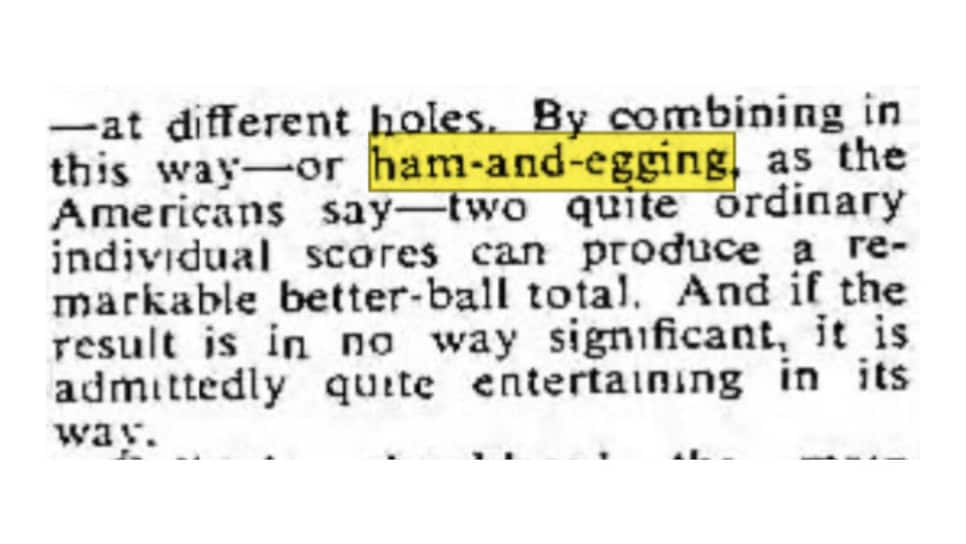
If “ham and egging” had been British, Dobereiner would have known about it.
9. By the late ‘60s, it was accepted golf slang
The term appears more and more over the years, and eventually—at least in some cases—loses the quotation marks that accompanied its early usage. By 1968, the author George Plimpton was referencing it in his book ‘Bogey Man,’ though he skimped a little on the definition, describing it as “combining in a good partnership,” and after that it gets relatively common. You even start to see it branch out to other sports like the Little League World Series, albeit rarely. By 1979, around 20 years after it first seems to have appeared, it was considered “an old golf” term, as you see from this quote by golf sicko and 1974 National League MVP Steve Garvey:
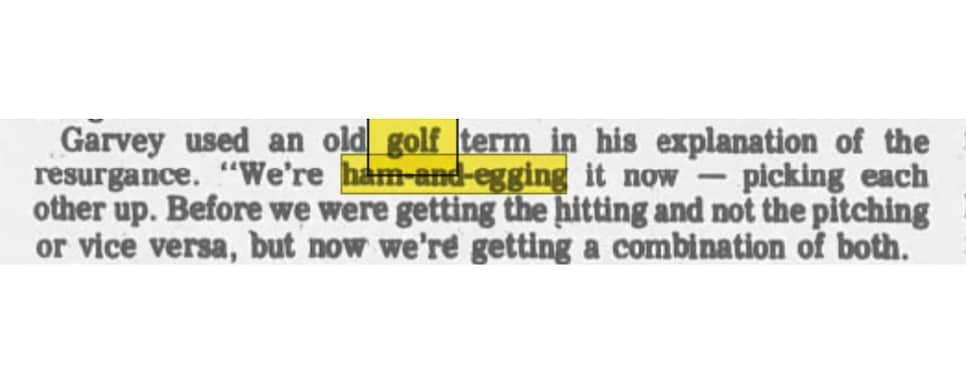 10. In conclusion …
10. In conclusion …
So, what can we take from this? The short version is that the term “ham and egg” as a metaphorical phrase predates golf by a very long time, but the meaning was very different. It seems to have made its way into golf lingo by the 1950s, appearing in print commonly by the ’60s. One origin story has it that the “ham” and “eggs” were the holes, with the idea being that the players would split the ham and eggs between them. How it came into being, though, remains a mystery—likely the work of some active mind following a good best-ball performance, hatching an expression so catchy that it spread throughout the west coast, then America, and then the world. But who that originator might be, or what he was thinking, remains elusive, and we’re stuck just like columnists in Lincoln, Neb., were stuck almost 50 years ago:
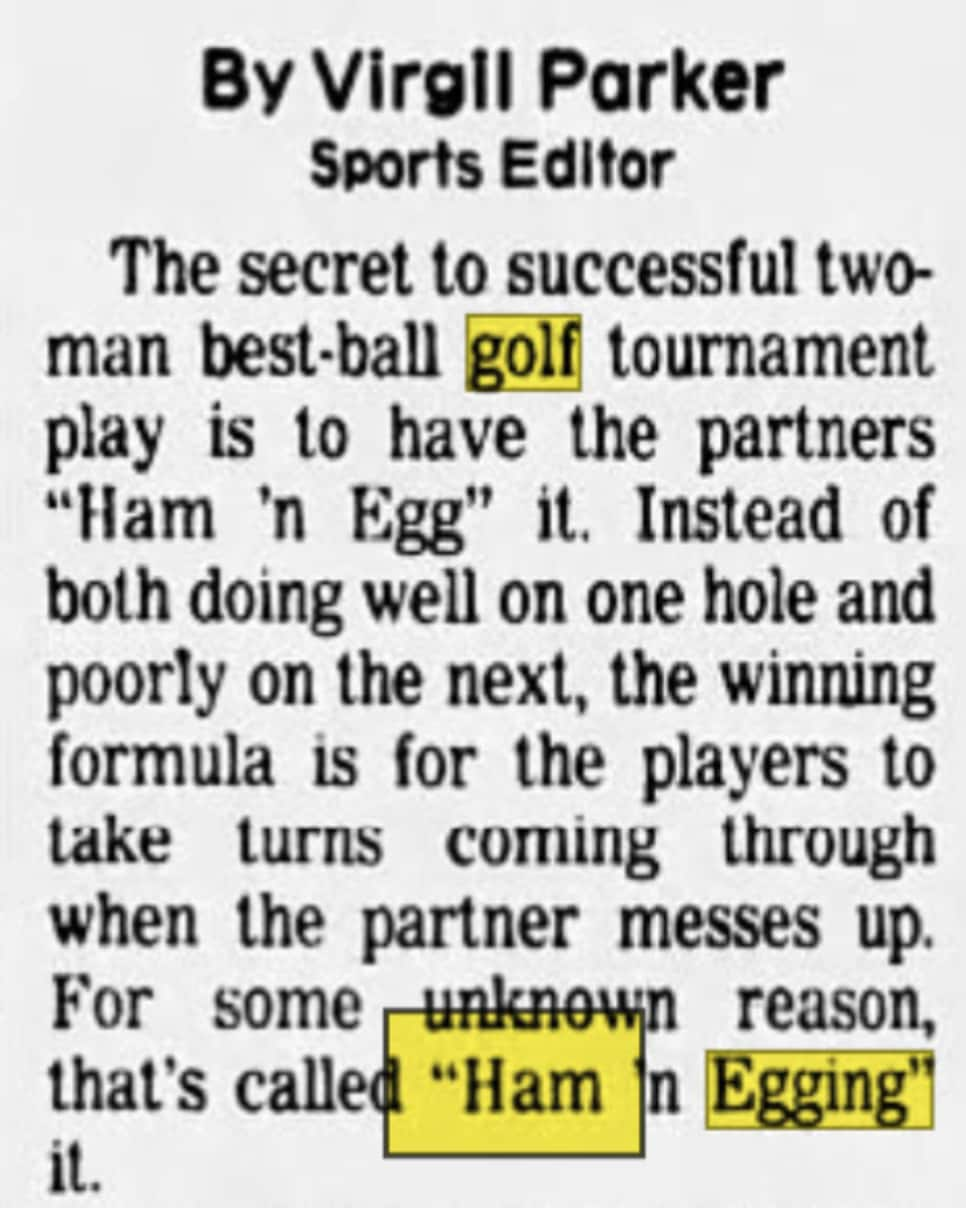
When you boil it down—no pun intended—”for some reason” is probably as much as we’ll ever know. But just like actual ham and eggs, I’m glad it’s a staple of our golf diet.
This article was originally published on golfdigest.com




